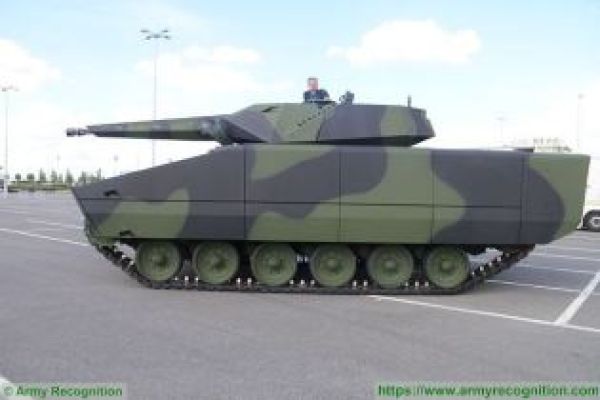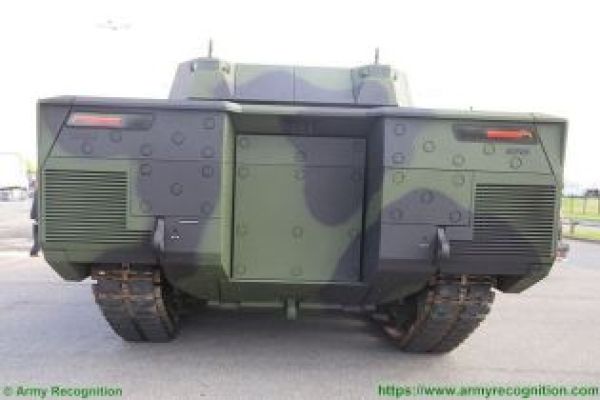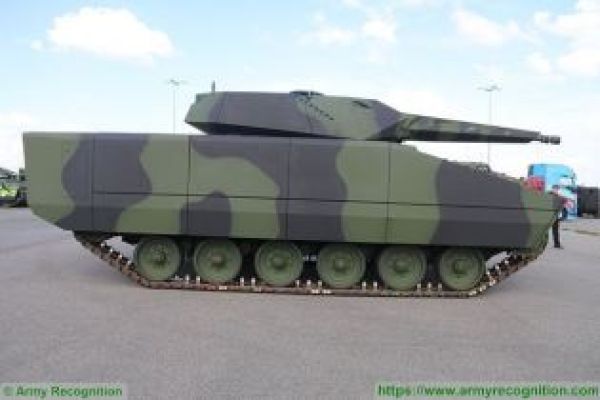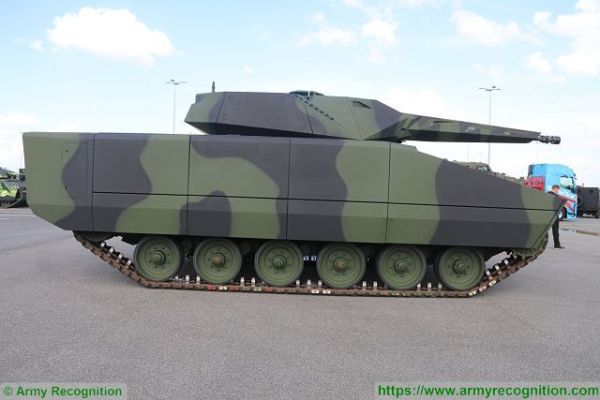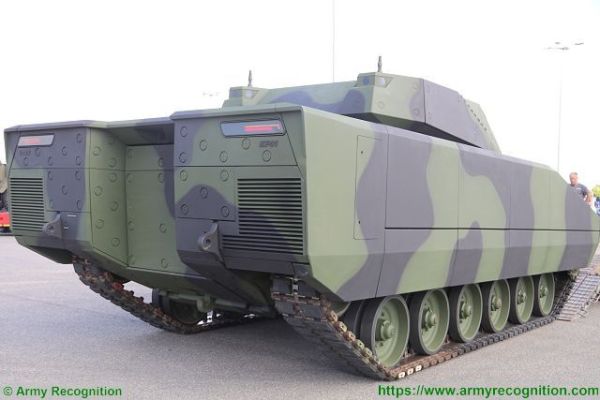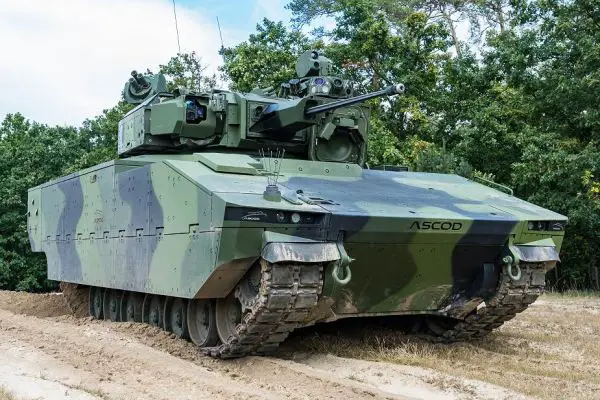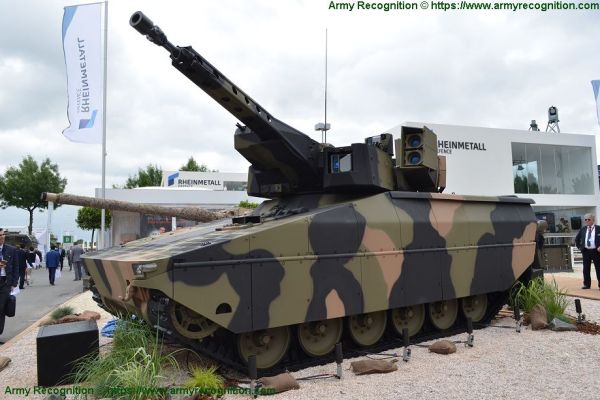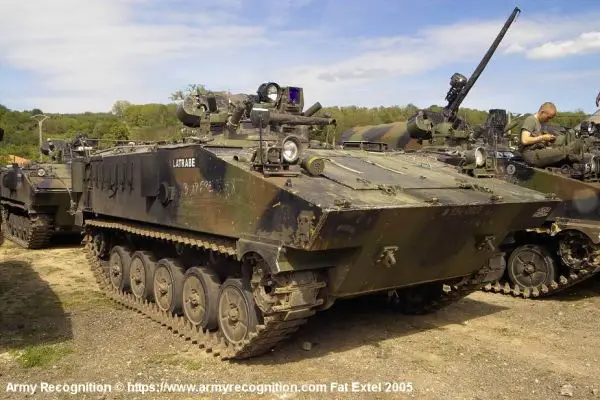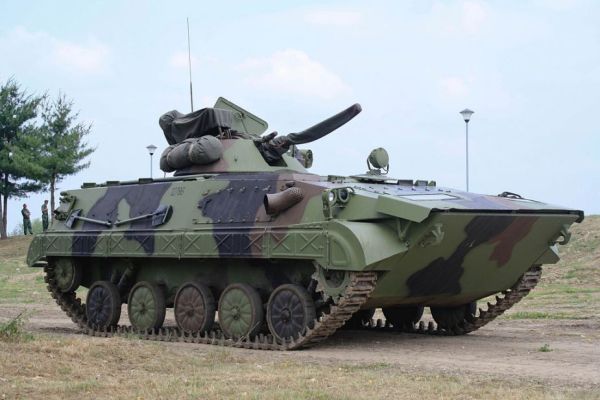TRACKED VEHICLES.
KF41 Lynx IFV.

The KF41 is an IFV (Infantry Fighting Vehicle) in the Lynx family of a tracked armored vehicle designed, developed and manufactured by the German Company Rheinmetall Defence. This vehicle is a longer version than the KF31 IFV unveiled in September 2016, 7.22 m for the KF31 and 7.7m for the KF41. It also has a more powerful engine and weighs 10 tons more than KF31.
Country users: Hungary
Description
The KF41 Lynx is an IFV (Infantry Fighting Vehicle) in the Lynx family of a tracked armored vehicle designed, developed, and manufactured by the German Company Rheinmetall Defence. This vehicle is a longer version than the KF31 IFV unveiled in September 2016, with 7.22 m for the KF31 and 7.7m for the KF41. It also has a more powerful engine and weighs 10 more tons than KF31. The KF41 was unveiled in June 2018 at Eurosatory 2018 in two configurations: IFV and Command Post. The KF41 has been designed to offer a new generation of tracked armored offering modularity and a high level of protection. The feature at the heart of the KF41 Lynx design concept is the separation and modularity of the vehicle into two primary parts: the basic vehicle and specialist mission and role equipment. Specific variants can be built around a common hull and common mobility assemblies and protection components, to which role and mission-specific equipment can be added according to customers' requirements. This design approach combines the functional, cost and through-life advantages of a modular structure, and the weight, space, and cost advantages of integral hull design. German Company Rheinmetall has offered the Lynx to the Australian Defence Force for Phase 3 of the Land 400 program, as well to the Czech Republic to replace the old BVP-2, a Russian BMP-2 tracked armored IFV produced under license in the Czech Republic. Rheinmetall defense in collaboration with American Company Raytheon has also offered the KF41 Lynx to meet the U.S. Army's requirement for the NGCV (Next-Generation Combat Vehicle-Optionally Manned Fighting Vehicle), a program to replace the Bradley IFV tracked armored Infantry Fighting Vehicle. In March 2019, Rheinmetall Defence lodged a bid in response to the Australian Army’s Land 400 Phase 3 - Mounted Close Combat Capability Request For Tender (RFT) with its KF41 Lynx Infantry Fighting Vehicle (IFV) fitted with the Lance turret. In August 2020, Hungarian armed forces have signed an agreement with German Company Rheinmetall Defense to produce Lynx IFV Infantry Fighting Vehicle. On September 10, 2020, German Company Rheinmetall has announced the order of 218 Lynx KF41 tracked armored IFVs for Hungary. In December, It was published that the KF41 will be manufactured in Hungary. The KF41 Lynx is also one of the candidates to replace the old Soviet-made tracked armored IFVs in service with the Czech Republic and Slovakia. Citing information released by the "Tactical Report" on March 15, 2022, Iraq has launched discussions to procure KF41 Lynx. At the AUSA defense exhibition that was held in Washington D.C., in October 2022, Rheinmetall presented a technology demonstrator based on the KF41 Lynx as one of the solutions for the US Army Optionally Manned Fighting Vehicle (OMFV) Program. This program was launched by the U.S. Army to replace the Bradley tracked armored IFV. On February 10, 2023, Greece approved the procurement of 205 KF41 Lynx. On December 2, 2023, the CEO of Rheinmetall Defense announced a plan to produce the KF41 Lynx in Ukraine. On October 26, 2024, during an interview with the German Newspaper, Rheinmetall CEO Armin Papperger announced the delivery of the first batch of 10 KF41 Lynx IFVs to Ukraine by the end of 2024.
KF41 Lynx IFV variants:
The KF41 Lynx family of tracked armored vehicles can be configured for a variety of roles that include command and control, armored reconnaissance, surveillance, repair, recovery or ambulance operations in addition to infantry fighting vehicle configuration.
- KF41 Lynx Reconnaissance:
- KF41 APC: the IFV turret is removed, armament consists of one remotely operated weapon station armed with one 7.62m machine gun. The rear of the hull has been raised to offer more internal space.
- KF41 Lynx Ambulance: the internal layout has been adapted to carry a medical team and wounded soldiers.
- KF41 Lynx Recovery: Same design and armament as the APC version. No turret, one crane is mounted on the roof of the vehicle
- KF41 Lynx Command Post: A version was shown in June 2018 during Eurosatory, defense exhibition in Paris, France. There is no turret, the same design as the APC version, with a new internal layout adapted for command and control.
- Lynx 120: This unique platform merges a tried-and-tested turret concept and the proven 120mm smoothbore cannon with the Lynx KF 41 chassis. The new mechanized fire support variant of the Lynx offers the user outstanding fire support and anti-tank capabilities.
Technical Data
-
Armament
The KF41 IFV (Infantry Fighting Vehicle) variant was presented at Eurosatory 2018 with A Lance 2.0 turret, the next generation of the in-service Lance family and has been developed to improve its suitability for an IFV. Lance 2.0 has various enhancements that provide a troop of Lynx KF41 vehicles with a very high level of organic capability, thus allowing the troop to have a disproportionate effect on the battlefield. The Lance 2.0 features enhanced protection for critical subsystems against kinetic and fragmentation threats, improving system survivability during close combat. The next enhancement is the integration of the new Wotan 35 electrically driven 35mm cannon that fires Rheinmetall’s proven and in-service 35x228mm ammunition family. The WOTAN 35 is the latest member of the WOTAN cannon family and, due to its larger caliber, delivers a longer range and deeper penetration than 30mm cannons. A 7.62mm coaxial machine gun is mounted to the left of the main armament. The Lance 2.0 turret also has two flexible mission pods fitted to the left and right of the turret that allow the installation of a variety of sub-systems to give the turret a specialist capability. Examples of customer-selectable mission pods include dual Rafael Spike LR2 ATGMs, non-line-of-sight strike loitering munitions, UAVs, or an electronic warfare package. The Lance 2.0 turret can be also armed with the proven Rheinmetall 30mm MK 30-2/ABM cannon and one 7.62mm co-axial machine gun. The 30mm cannon has a maximum elevation and depression of +45 degrees and -10 degrees. The roof of the turret can be equipped with remotely-controlled Main Sensor Slaved Armament (MSSA) that works in conjunction with the commander’s panoramic sight and is armed with one M2QCB 12.7mm heavy machine gun. The lance turret can be configured in manned and unmanned versions operated from workstations within the hull rear. The Lynx turret could also integrate loitering munition to be used as an anti-tank weapon.

Close view of the KF41 Lynx IFV turret armed with one 35mm Cannon -
Design and protection
The KF41 Lynx has a unique design using a common drive module and a flexible mission kit arrangement to allow any base vehicle to be configured as an IFV, an armored personnel carrier, a command vehicle, a recovery vehicle or an ambulance. The driver position is located at the front left side of the hull. It has three large vision blocks offering excellent front and side vision. The mission kit includes a drop-in roof plate that can be fitted to any drive module with associated equipment to create a Lynx variant. A mission kit on a Lynx KF41 can be exchanged and the protection configuration modified within 8 hours. The crew compartment is designed as a mission-neutral space with the incorporation of C-rails and a pattern of universal fixing points on the walls and floor. This provides a flexible configuration for all mission-specific equipment. The internal volume of the Lynx KF41 drive module is unrivaled for a tracked IFV with a manned turret. Eight dismount seats can be seen here folded up, with the Lance 2.0 turret basket in the background. The drive module has space for up to nine blast-attenuating troop seats, in addition to a crew of three in the case of a manned Lance 2.0 turret. The infantrymen enter and leave the vehicle through A large power-operated ramp mounted at the rear of the common drive module, positioned between the cooling systems. Troop seat spacing accommodates 95th percentile male soldiers wearing body armor. The modular survivability systems of the Lynx provide unprecedented flexibility for customers to cope with the wide variety of threats faced across the spectrum of conflict. The ballistic and mine protection packages can be easily exchanged, even in the field if needed, while the full spectrum of threats has been taken into account, including roof protection against cluster munitions. The Lynx KF41 with Lance 2.0 has been designed not only for passive and reactive systems but also for an active protection system to defeat rocket-propelled grenades and antitank-guided missiles. The Lance turret of the KF 41 Lynx is designed with an internal ballistic protection cell for the crew. There are no weapons or ammunition stowed in this cell (co-axial weapon ammunition is stored separately), and the main and co-axial weapons are fitted in cradles at the front of an external to the cell. This means that a range of qualified 30mm and 35mm cannons can be fitted to Lance without changing its fundamental design. The main armament ammunition is stowed in a separate compartment that wraps around the sides and rear of the turret. This physical modularity and separation achieves higher levels of protection, crew safety, and accuracy whilst providing a growth path for future upgrades.
-
Mobility
The KF41 Lynx has a powerpack in the front of the hull including an 850 kW (1140hp) Liebherr engine and a proven Renk transmission. The final drives are mounted in the front and the idler sprockets with track tensioners are mounted at the rear. The running gear has six road wheel stations per side, which guide a lightweight end connector track. The road wheels are mounted on a well-proven suspension system comprising swing arms with conventional torsion bars and damper systems which are both reliable and cost-efficient. The suspension system has been developed by Supashock, an Australian company, meaning the Lynx can be configured to carry various mission kits and survivability packages without compromising mobility. The upper part of the suspension is protected by armor plates. When configured for mounted combat operations with the Lance 2.0 turret and a survivability package suitable for peer-on-peer combat, the Lynx KF41 weighs approximately 44 tones. In this configuration, it provides class-leading mobility due to the high power-to-weight ratio of 26 hp/t, while still leaving up to six tones of reserve payload for future growth. The engine cooling system consists of two coolers on the left and right rear sponsons. This provides the lowest possible infra-red (IR) signature, optimal ballistic protection, and a well-balanced center of gravity. The KF41 Lynx can run at a maximum road speed of 70 km/h with a maximum cruising range of 500 km. It can negotiate a gradient of 60% and side slopes of 30%. It can cross a trench of 2.5m, climb a vertical obstacle of 1 m and has a fording depth of 1.5m without preparation.
-
Combat Equipment
Standard equipment of the KF41 Lynx IFV includes heating, air-conditioning, fire suppression, cooling and nuclear, biological and chemical filtration system combined in an environmental control system. The vehicle is also fitted with a self-protection system including the Rheinmetall 40mm Rapid Obscuration System (ROSY) and APS (Active Protection System) designed to prevent line-of-sight guided anti-tank missiles/projectiles from acquiring and/or destroying a target. The vehicle design also presents low visual, thermal, and acoustic signatures to improve battlefield survivability. To reduce its thermal signature, for instance, the engine exhaust outlet has been moved to the rear of the vehicle and the exhaust mixed with the radiator cooling efflux to reduce the temperature of the expelled exhaust. A new shroud is also fitted over the barrel of the main armament that reduces thermal and radar signatures. The commander’s and gunner’s stations have common human-machine interfaces, each with a duplex controller and central multi-function display. The commander and gunner have a common main operational panel and a common Battle Management System (BMS) display. The turret of the KF41 Lynx is equipped with an electro-optical sensor system (SEOSS) panoramic sight with an integrated laser rangefinder and FCS for the commander and gunner, SEOSS (Stabilized Electro-Optical Sensor System) sector sight with an integrated laser rangefinder and FCS for the gunner, laser warning system, acoustic shooter locating system, situational awareness system featuring day/night vision and automatic target recognition and Video processing and distribution unit. The optronics enables the turret crew to have unrestricted and class-leading capabilities for automatic detection, recognition, and identification of targets whilst maintaining observation by day and night and staying protected inside the turret. The optronics and laying system enable precise engagement of targets and the two SEOSS sights and independent weapon systems provide a ‘killer-killer’ capability. There is 360° independent digital sight for the commander (SEOSS-P) and digital sight for the gunner (SEOSS-S). To analyze situational awareness, the vehicle also has 360° TV/ IR cameras networked with the SEOSS-P and SEOSS-S.
Specifications
-
Armament
One 30 or 35mm automatic cannon, one 7.62mm coaxial machine gun
-
Country users
Hungary
-
Designer Country
Germany
-
Combat Equipment
360° independent digital commander’s sight (SEOSS-P) and digital gunner’s sight (SEOSS-S), 360° TV/IR cameras networked with SEOSS-P and SEOSS-S, Automatic Target Recognition and Tracking, Laser Warning and Acoustic, Shooter Locating System, Battle Management System and Tactical
-
Crew
2 + 8 soldiers
-
Armor
The modular armor concept provides protection against antitank weapons, medium-caliber ammunition, artillery shrapnel, IEDs, and artillery shell splinters.
-
Weight Vehicle
34,000 to 50,000 kg
-
Speed Vehicle
70 km/h road speed
-
Range Vehicle
500 km
-
Dimensions
Length: 7.7 m; Width: 3.6 m; Height: 3.3 m





















